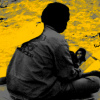Kate Pullinger and Chris Joseph’s “Flight Paths” is a digital story told through different episodes. Within each episode there are images, sounds, and texts that prompt the reader to move through each. In order to progress within the story, you must press an icon that takes you deeper into what is going on. “Flight Paths” is about two different lives colliding with one another. At first it is about a young man escaping from his country to become a worker in Dubai. Eventually this young man's story collides, literally, with the story of woman in a supermarket parking lot when the worker from Dubai falls from an airplane onto the woman’s car in the parking lot.
The way this story is formatted is very stimulating. It keeps the reader intrigued by forcing the reader to press an icon to continue the story (see the first screenshot). The icon does not stay in the same spot, so you must follow it as it moves as the story plays. In this story, you don’t see the faces of the characters. Instead, many shadows cover them so that you only see outlines of them (see, for example, the second screen shot).
“Flight Paths” reminded me of a combination of a movie and a book. With a movie, you don’t need to press or turn anything to keep the story going. You just have to sit back and watch the scenes and hear the sounds. With a book, you have to turn each page in order to progress. This digital story is blend between the two, which is refreshing. It is like a book because you must press an icon to move on, just like turning a page. A positive aspect in this is that you are paying attention since you pace yourself in your progression through out the story. It is like a movie because it has images and sounds while the story is playing. A pro to this is that it makes the story more interesting and lifelike because it portrays the scenes visually rather than requiring the reader to imagine them as she might have to with a book. In this way it is more visually appealing to the reader.
Even so, “Flight Paths” was very frustrating to me. If Pullinger and Joseph did not provide a summary before hand, I would have been very confused throughout the story. The images and sounds fit in, but the story was at time very vague. There were moments where I had to go back to the summary to try and understand what was going on. I do not feel the story went into as much depth as it should have. Another frustrating aspect of this story was that there were no opportunities to go back. If you hit the icon to move on, many pictures would flash before you without giving you the opportunity to digest them; there were many times where I had to completely restart an episode because I did not catch the scenes the first time. The pace was set too fast for this story; it would be improved if you had to click the icon to exam each picture. With a book or movie, you can pause where you are. In this electronic story, there was no pausing or rewinding.
A theoretical perspective that might help a reader to further understand this work would be that of post colonialism. According to Mary Klages in “Literary Theory: A Guide for the Perplexed,” postcolonial theory is “centrally concerned with examining the mechanisms through which the colonizing powers persuaded the colonized people to accept a foreign culture as better than their own indigenous methods of government and social organization.” The third screenshot below is a is from the opening scene in the first episode. In this moment the narrator is explaining that he left his “colonized people” to enter into a “foreign culture” so that he could make a better living. It provides a apt example of post colonial theory as Klages defines it.
Amanda Foulon was a student of Dr. Lisa Swanstrom for a course in Literary Theory taught at Florida Atlantic University in the Spring term of 2014.

